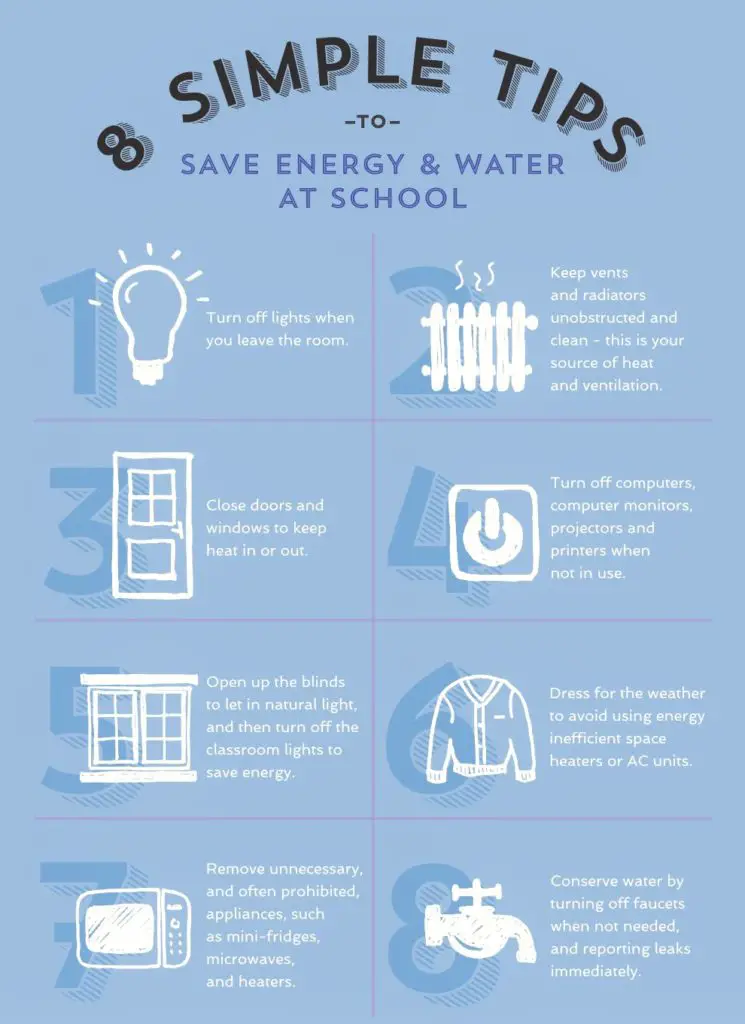Electricity consumption in schools is mainly because of two main sources of power consumption one is the HVAC system which includes AC’s and ceiling fans and another is lighting.
In this article, we will see in detail how every school can save a considerable amount of their electricity bill by making few small changes.
Here is a brief list of all the tips to save electricity in school, we will look into each one of them in detail.
- Change Your School Lighting To LEDs.
- Use Natural Lighting Whenever Possible.
- Change Your School’s Ceiling Fans To BLDC Fans.
- Apply Reflective Paints To Keep The Building Cool.
- Use ACs efficiently.
- Install Solar Power Generation System.
- Turn OFF Appliances After School.
- Update Your Computers To New One.
Before we discuss all the tips in detail and see how much saving in electricity bill we can have from each one of them, it is important to establish that some of the tips which we are about to discuss will give you great savings in electricity bill but will require some amount of financial investment and other tips which don’t require any financial investment will be more of a lifestyle change which all the teachers and students will have to do.
7 Ways To Save Electricity At School:
1. Change Your School Lighting To LED: Since almost all the schools are open in the morning and afternoon (when the sun is out), they should take advantage of natural sunlight for their lighting needs. However, if it’s not possible to use natural lighting in your classroom then make sure you install the energy-efficient LED bulbs.
We all know that LEDs are energy efficient but how much savings can they really give?
Let me give you a comparison between LED, CFL, and incandescent light bulbs.
Imagine school A has 100 Incandescent bulbs to power their entire building, school B has 100 CFL light bulbs to power their entire building and school C has 100 LED light bulbs to power their entire building, which school will save maximum electricity and thus low electricity bill?
For simplified calculation let’s assume all light bulbs give out 1,100 lumens. Hence to produce 1,100 lumens each light bulb requires the following wattage.
- Incandescent light bulb – 75 watt.
- CFL light bulb – 18 watt.
- LED light bulb – 12 watt.
- Assuming – Electricity tariff is Rs 10 / unit
| Sr No | School A | School B | School C |
|---|---|---|---|
| Type of bulb | Incandescent | CFL | LED |
| No of light bulb | 100 | 100 | 100 |
| Each bulb wattage (Watt) | 75 | 18 | 12 |
| Daily Operational Hrs | 8 | 8 | 8 |
| Daily Power Consumption (kWh) | 60 | 14.40 | 9.60 |
| Monthly Operational Hrs | 192 | 192 | 192 |
| Monthly Power Consumption (kWh) | 1,440 | 345 | 288 |
| Average Monthly Electricity Bill | Rs 14,400 | Rs 3,450 | Rs 2,880 |
| Average Annual Electricity Bill | Rs 1,72,800 | Rs 41,400 | Rs 34,560 |
Note: I live in Mumbai, India that’s why I have used currency as rupees, Don’t worry if you live in India, US or Cambodia the amount will be proportional, what matters is the percentage of saving you can have by this simple switch.
As you can see that if you are school is still using incandescent light bulbs then the electricity bill you will get is almost 5 times (500%) than what you will get for using the same number of LED bulbs.
This change will not cost you much and the savings will be for many years in the future.
2. Use Natural Lighting Whenever Possible: As you saw above the power consumption from light bulbs is a lot, so it’s wise to switch to LED’s but if your school can afford it then put emphasis on using natural lighting in your classroom whenever possible.
3. Change Your School’s Ceiling Fans: Ceiling fans are the only appliances that are running for the entire duration of school (unless your school has air conditioners), hence it is best to find a way to reduce their power consumption.
Obviously switching it OFF is not an answer hence the best possible option is to switch to the energy-efficient models if possible.
The only which I will recommend is the one equipped with Brushless DC motors (BLDC), They consume 40 % to 50 % less energy than traditional ones thus reducing your hefty electricity bills.
To give you a rough idea a 1200 mm sweep traditional fan has 60 – 70 watts whereas BLDC fans are of 32 – 45 watts for the same size.
Again if your school cannot afford to replace all the ceiling fans then do it in a phase-wise manner.
4. Turn OFF Appliances After School: I know, that you will be saying everyone knows this but unless we understand how much electricity bill we can save most of us be it students or teachers will never pay attention and give importance to something like this.
Let’s see an example, there are 10 classrooms in your school and every 5 classrooms leave 1 fan (70 watts) and 2 light bulbs (20 watts each) running every day after school. (school is for 14 hours hence for 10 hours it is unnecessarily running).
| Events | Data |
|---|---|
| Total Wattage (70 + 40) (watt) | 110 |
| Daily Power Consumption For 10 Hours | 1.10 |
| Monthly Power Consumption (kWh) (for 24 days only) | 26.4 |
| Monthly Electricity Bill In This Situation (Rs) | Rs 264 |
As you can see that you will have to pay Rs 264 every month even if just 5 classrooms leave 1 fan and 2 light bulb ON in after school hours
If a large number of appliances are kept ON even after school hours then your school will lose a lot of money on electricity bills.
Schools should try to shows students actual figures like these and make them realize that if they take positive action it will help the school and the environment in a good way.
5. Update Your Computers To New One: Computers, projector screens and all other audio visual devices consume a lot of power too. Now you cannot stop using them but certainly can do few things.
Few tips to save electricity on your PC’s is:
- Change the brightness of all PC’s to medium level.
- Disconnect all external devices like printers, webcams when not in use.
- Remove screen savers & change the settings of your PC’s to go in sleep mode if there is no activity. (I know they look cool sometimes but consume power as well).
- Turn OFF PCs when not in use (No standby or sleep mode, Turn it OFF from the main switch).
- If your school is still using old PC’s then please replace it with a new one (at least replace those which are continuously used, like administration PCs).
6. Apply Reflective Paints: If your school is fully air-conditioned then try coating reflective paints on the walls which receive direct sunlight, this will definitely reduce a lot of load on your air conditioners and save you some real money.
7. Use AC’s efficiently: If your school has air conditioners then they are the ones raising your electricity bill. Obviously you cannot replace all the AC’s to energy-efficient ones but you can certainly save a lot of power by using them wisely.
Here are few tips to reduce power consumption of air conditioners.
- Set the thermostat at 24 degrees Celsius or above it and use ceiling fans for proper air circulation.
- Clean all the AC filters every month.
- Keep all the compressor units in shade and also clean them in a couple of months.
- If direct sunlight is coming in the room then cover the windows with thick drapes and use paint that wall with reflective paint.
Check out this article for more detail – How to reduce ac power consumption and save electricity.
How Solar Can Save School Electricity Bill:

The last resource which I feel is the best option is to install a solar on-grid system in your school.
You can check out this article to learn more about it – What is a solar on-grid system?
As most schools are working when the sun is shining, they can harness a lot of electricity and use it to power their own building.
If your school Installs a 20 kW solar system on its rooftop then savings will be as follows. I am assuming an electricity tariff of Rs 10 and an average monthly power generation of 1 kW solar system to be 100 kWh.
- Monthly power generation from solar – 2000 kWh
- Annual power generation from solar – 24,000 kWh
- Monthly savings in electricity bill – 2000 X Rs 10 – Rs 20,000
- Annual savings in electricity bill – Rs 2,40,000
The figures are approximate and will be more for places which receive lots of sunlight ( above 300 days of sunlight with each day getting 6 hours of sunlight) and low for places which receive less sunlight.
Apart from these tips try cultivating a habit of energy savings among all your students through workshops because you will need their assistance in saving your electricity bill successfully.

If you like this article please give it a thumbs up and feel free to share it on WhatsApp, Facebook, Pinterest, Reddit and anywhere else.
If you have implemented any of the above strategy or any other strategy in your school and saved some electricity bill then please share it in the comments section it will inspire other as well.
Thank you for reading.
Have a nice day, bye bye 🙂
Important Resources:
- https://www.energy.gov/energysaver/save-electricity-and-fuel/lighting-choices-save-you-money/led-lighting#:~:text=Energy%20Savings,times%20longer%2C%20than%20incandescent%20lighting.
- https://www.researchgate.net/publication/254088160_Reducing_Energy_Consumption_and_Creating_a_Conservation_Culture_in_Organizations_A_Case_Study_of_One_Public_School_District





